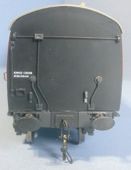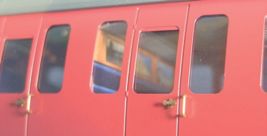Darstaed British Railways Mark 1 Suburban (Non-gangwayed) coaches
Darstaed Trains De Luxe
- Models loaned by Ellis Clark Trains
| Failed to open database: gaugegu1_gog2 | ret is false |
Ellis Clark has very kindly supplied two of Darstaed's new non-gangwayed BR Mk 1 coaches. They arrived just in time to take some pictures and allow a brief evaluation before this issue was due at the printers. We carried a review of the first of their Mk1 corridor stock in the May 2018 Gazette, and much of what I said there regarding the structure of the models applies to these vehicles too. For any member without a hard copy of that issue and wishing to see that review, I would direct them to the Gazette Archive which can be accessed through the Guild's website.
The prototypes
BR Mark 1 corridor coaches first went into revenue service in the spring of 1951, the better part of 70 years ago.
The non-gangwayed coaches, often referred to as suburbans or non-corridors by modellers, first appeared a few years later in 1954. They were built in various BR workshops and a surprisingly large variety of types, fourteen in all, to two different lengths, were eventually in service. The were built to the same profile as the corridor stock and some types were produced to what was called 'Metrogauge' for working services around London. These latter types had roof vents fitted lower on the roof, that is, they were further offset from the longitudinal centre line of the roof, to keep them within the loading gauge of the old Metropolitan Railway. The non-gangwayed stock appeared at much the same time as diesel multiple units were arriving and by the end of the 1950s no further construction was undertaken. Coaches were delivered to the Eastern, Western, London Midland, Southern and Scottish regions although some of the diagrams were specific to particular services. The early deliveries of vehicles appeared in the unlined crimson (blood) livery, later on, maroon apeared, lined for some and unlined for the majority, some lasted to become Rail Blue in the later 1960s and 70s. I believe some may have been in green for the Southern region. My initial research suggests these were the longer versions and perhaps a Guild member might confirm if this is the case and possibly what versions ran in green.
A number of the coaches survived until the very end of non-gangwayed services on British Rail, and indeed some were included in the very last scheduled service from King's Cross to Royston at the end of September 1977.
The non-gangwayed stock was the only BR standard stock to have designated 'ladies only' compartments. These were normally adjacent to a guard's compartment and usually non -smoking. The markings were removed from the stock still in service in 1975 after the passing of the Sex Discrimination Act.
The model
 The production samples reviewed here are a 57ft open second and a 57ft nine compartment second, both in crimson. The crimson paint is dense and looks particularly good in bright sunlight. They are identical on the outside the main difference being that the open second interior is in two saloons with a dividing cross wall around halfway along the length. Other types being produced are: composite, composite lavatory, brake second, second with lavatory. All are to the 57ft length and available in crimson, lined and unlined maroon, and blue.
The production samples reviewed here are a 57ft open second and a 57ft nine compartment second, both in crimson. The crimson paint is dense and looks particularly good in bright sunlight. They are identical on the outside the main difference being that the open second interior is in two saloons with a dividing cross wall around halfway along the length. Other types being produced are: composite, composite lavatory, brake second, second with lavatory. All are to the 57ft length and available in crimson, lined and unlined maroon, and blue.  End handrails, lamp brackets and electrical
connectors and switchgear are present.
End handrails, lamp brackets and electrical
connectors and switchgear are present. Door furniture includes seperately fitted handles and grabrails. The door stops are just visible in this picture and could be improved with a spot of black paint.
Door furniture includes seperately fitted handles and grabrails. The door stops are just visible in this picture and could be improved with a spot of black paint.
As with the earlier corridor versions, a mixture of etches, mouldings and diecastings is used and in the main, the parts are screwed and/or clipped together. The etched sides are beautifully painted to a standard that most of us would fail to match. The underframe trussing and fittings, ends, roof and roof fittings are self-coloured ABS mouldings, black or grey as appropriate. Curiously, the roof has ribs running crosswise all along its length. Pictures of the prototypes don't show this but it could be fairly easily removed should a fastidious purchaser desire. Roof vents are neatly fitted moulded items.The brake rigging between the bogies is fairly fine and delicate and needs treated with care. The ends are well detailed with handrails, steps, alarm gear, lamp irons and electical connectors and switch gear. The floor pan, solebars and steps are metal, and the bogies are diecast metal with very free running, turned metal, wheels on pinpoint axles in brass bearings. The oval headed buffers are sprung and do not rotate. Screw couplings, adjustable for length, are fitted and centre area of the headstock is screwed in place and could be easily removed to fit Kadee or similar automatic couplings.  The compartment interiors include coloured pictures on the walls and luggage racks above the seats.
The compartment interiors include coloured pictures on the walls and luggage racks above the seats.
The BR 1 bogies are compensated and the sideframes are screwed to the central frame. Brake shoes and hangers are fitted and are in line with the wheels but no operating linkage is present on the bogies. One bogie has pickups for the interior lighting and there is a miniature slide switch to turn the interior lights off and on. The bogies are mounted to provide a three point suspension, one allows fore and aft rocking and the other side to side, resulting in a very smooth and completely wobble free ride. Underframe trussing and details
Underframe trussing and details One bogie is fitted with pick ups for the internal lighting. The centre section of the headstock can be removed to allow fitting of Kadee couplers.
One bogie is fitted with pick ups for the internal lighting. The centre section of the headstock can be removed to allow fitting of Kadee couplers.
| Dimensions | Prototype | Model |
|---|---|---|
| Length over headstocks | 56ft 11in | 57ft 1½in(401mm) |
| Bogie centres | 40ft 0in | 40ft 0in (280mm) |
| Bogie wheelbase BR 1 | 8ft 6in | 8ft 6in (60 mm) |
| Wheel Diameter | 3ft 6in | 24.7mm on tread |
| over flange | 26.85mm | |
| Wheel width | N/A | 3.65mm |
| Back to back | N/A | 29.1mm |
| Flange thickness | N/A | 0.70mm |
| Height above railhead to: Top of roof arc | 12ft 4 ½in | 12ft 3in (85.6mm) |
| Body widths: | ||
| At floor | 8ft 8½in | 8ft 10in(62.6mm) |
| Maximum (ex door handles) | 9ft 0in | 9ft 2in (64.6mm) |
| At cantrail | 8ft 7in | 8ft 8in (60.9mm) |
Weight of model: 1030g (nine compartment second) The prototype measurements are as given in Keith Parkin’s book on the story of BR Mark 1 coaches published by HMRS/Atlantic.
The BR 1 bogies are a great advance on the version fitted to the corridor coaches reviewed earlier, both in terms of width (53.1mm across the axleboxes compared to over 59 mm on the version reviewed last May) and larger, very close to scale, diameter wheels.
Other improvements include individually fitted door handles and grab handles and a repesentation of the door 'bump stops'. On a plain, single coloured side these add considerably to the overall appearance. To improve things further and included as an extra, for modellers to fit themselves, are moulded door hinges. One of the pictures shows some of these hinges in place but not painted. The moulded hinges are supplied for fitting by the user.
The moulded hinges are supplied for fitting by the user.
The coach is suplied un-numbered/unlettered and waterslide transfers are supplied. These have regional prefix letters, a selection of numbers appropriate to the coach type signs and class markings as required. An instruction and information booklet will also be included.
Moulded interior partitions and seating, and coloured compartment furnishings such as mirrors, lamps are all there. The colour is achieved with paper overlays and looks effective. There are etched luggage racks above the seats crying out for a few items of clutter to make them more apparent. One of the pictures shows the luggage racks and these are more apparent in the open saloons than in the compartment stock. The glazing is very secure.
Lighting is by LEDs on a light bar screwed in place above the compartments and as already mentioned, is switchable off and on via one of the bogies. Roof detail shows up clearly here.
Roof detail shows up clearly here.
These coaches are likely to be a welcome addition to the ever increasing range of RTR stock. Darstaed are to be commended on dealing with dimensional inaccuracies from the corridor range.The models encompass the period of transition from steam to diesel traction across the UK and are suited to both types of haulage. For those wanting something to run straight from the box, they're ideal for small and large railways. For modellers attracted to theminutiae of small details the fact that the coaches come in a number of versions and that the prototypes came from various workshops means they can have a field day personalising their own models.





